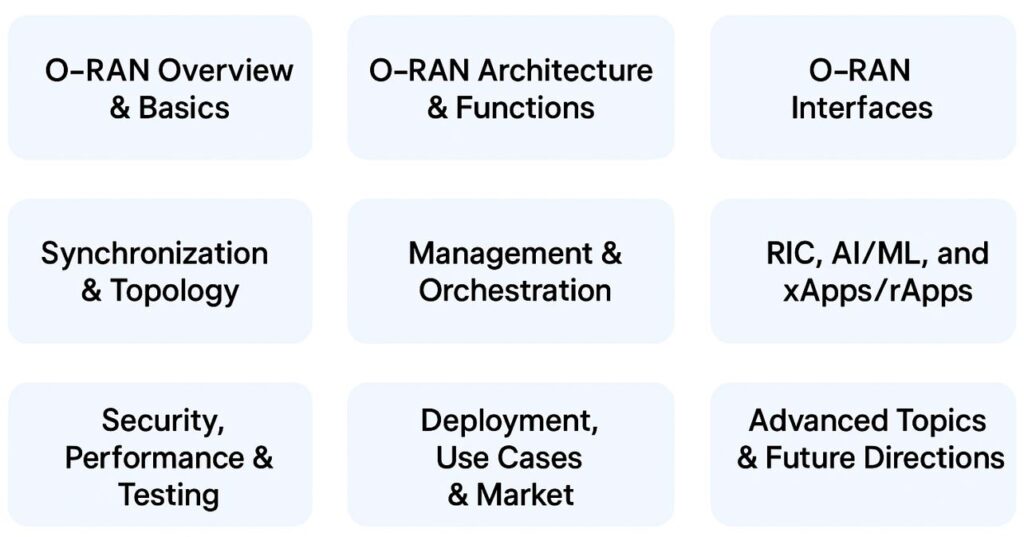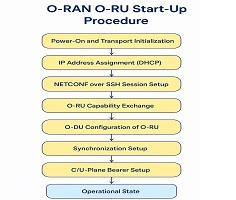O-RAN Interview Questions
In this post, we have put most asked interview questions about Open RAN/O-RAN in various Telecom Companies/Service Provider who are developing Open RAN systems.

- What is Open RAN, OpenRAN and ORAN?
- What is O-RAN ALLIANCE?
- What is Open RAN Policy Coalition?
- what C-RAN, Virtual RAN (vRAN) and OpenRAN?
- What is Near RT RIC ?
- What is Non-Near RT RIC?
- Non Real-Time RIC is connected with the Near Real Time RIC on which interface ?
- Function of 5G NR F1 Interface.
- Explain Reference Architecture for O-RAN.
- Explain about O-RAN working Group.
- What is an Open DU? Explain its architecture.
- What is an Open RU? Explain its architecture.
- What is the difference between Category A and Category B Open RU?
- What is Open Fronthaul?
- Which Workgroup is responsible for CUS plane specifications?
- What are the Plane available on Open Fronthaul?
- Explain Sync topologies for O-RAN Fronthaul.
- What is is PTP, and How it works?
- What is PTP IEEE standard and what are available profile for PTP?
- What is Xapps?
- What do you mean by Open RAN inter-operability?
- What are the test tools available for Open RAN interoperability testing
O-RAN Overview & Basics
- What is the full form of O-RAN and what is its main objective?
- Briefly describe the journey from traditional RAN to O-RAN.
- What motivated the creation of the O-RAN Alliance?
- Name at least three founding members of the O-RAN Alliance.
- Explain how O-RAN promotes multi-vendor interoperability.
- What are the three main pillars of O-RAN?
- Define the term “open interfaces” in the O-RAN context.
- What is the difference between open RAN and virtualized RAN (vRAN)?
- Explain the importance of “disaggregation” in O-RAN.
- How does O-RAN impact vendor lock-in for operators?
- What is the difference between proprietary RAN and O-RAN?
- Describe the O-RAN approach to RAN intelligence and automation.
- How does O-RAN support innovation and ecosystem growth?
- List two major global operator groups actively driving O-RAN adoption.
- What role does open-source software play in the O-RAN ecosystem?
- How does O-RAN drive down the cost of 5G deployments?
- What is “white-box” hardware and why is it important for O-RAN?
- How does O-RAN facilitate the deployment of small cells?
- Explain the term “RAN sharing” and how O-RAN enhances it.
- What is the relationship between 3GPP and O-RAN specifications?
O-RAN Architecture & Functions
- What are the main building blocks of O-RAN architecture?
- What is the primary function of the O-RU (Radio Unit)?
- What is the O-DU (Distributed Unit) responsible for?
- What are the O-CU (Centralized Unit) main roles?
- What is the SMO (Service Management and Orchestration) in O-RAN?
- Describe the role of the RAN Intelligent Controller (RIC).
- Differentiate between Near-RT RIC and Non-RT RIC.
- What are xApps and where do they run?
- What are rApps and what is their purpose?
- Which O-RAN node interfaces directly with user equipment (UE)?
- Which O-RAN node is responsible for MAC/PHY layer functions?
- Which node typically handles RRC and SDAP processing?
- What is the role of the Network Management System (NMS) in O-RAN?
- Explain the hierarchy between SMO, RIC, and DU/CU.
- What is the function of the Management Plane (M-Plane)?
- What is the CUS-Plane and what are its sub-planes?
O-RAN Interfaces
- Explain the purpose of the O1 interface.
- What is the O2 interface and its role?
- What is the E2 interface used for?
- What is the A1 interface and between which nodes does it run?
- What are the standard interfaces between O-RU, O-DU, and O-CU?
- Explain the function and structure of the open fronthaul interface.
- What protocol is commonly used over the open fronthaul (O-DU to O-RU)?
- What is eCPRI and why is it preferred over CPRI in O-RAN?
- What are the Control, User, and Synchronization Planes (CUS) in O-RAN?
- Explain the responsibilities of the M-Plane in O-RAN.
- What protocols are used for M-Plane management?
- Describe the use of NETCONF/YANG in O-RAN.
- What is SSH used for in O-RAN M-Plane communications?
- What is the function of the O-RU “Call Home” feature?
- O-RAN Functional Splits & Timing
- What is a functional split in O-RAN?
- List all 3GPP-defined functional split options and their split points.
- What is the most widely adopted split option in O-RAN and why?
- Describe Option 7-2x split and its main advantages.
- Compare high-layer and low-layer functional splits.
- What are the main data flows in Option 7-2x split?
- What are the trade-offs between Option 2 and Option 7-2x splits?
- How does functional split impact fronthaul bandwidth requirements?
- What data flows are exchanged on the User Plane (U-Plane)?
- How are IQ samples transmitted in the O-RAN fronthaul?
- Control/User/Synchronization Planes
- What is the Control Plane (C-Plane) responsible for in O-RAN?
- What are the main functions of the User Plane (U-Plane)?
- Describe the Synchronization Plane (S-Plane) and its importance.
- What is the role of an IEEE 1588 Grand Master in O-RAN?
- What is the purpose of the S-Plane protocol stack?
- What timing parameters must be managed for C-Plane and U-Plane coordination?
- What is Tcp_adv_dl and why is it important?
- Explain how C-Plane and U-Plane transmission windows are aligned.
- How does O-RAN handle PRACH IQ data transfer?
- What is Data Flow 1a, 1b, and 1c in U-Plane?
Synchronization & Topology
- How is time synchronization distributed in an O-RAN network?
- What is SyncE and how is it used in O-RAN?
- What are the compliant O-RAN timing topology configurations (LLS-C1 through LLS-C4)?
- What are the reference points R1, R2, R3, R4, and Ra in O-RAN?
- What are T12 and T34 delays in O-RAN?
- How does the O-DU function as a Grand Master for synchronization?
- What is the impact of excessive hops/switches on PTP performance?
- What does Full Timing Support mean in O-RAN synchronization?
- What are T-BC and T-TC switches and their relevance to O-RAN?
- What issues may arise if O-DU and O-RU are not properly synchronized?
Management & Orchestration
- What are the main FCAPS functions provided by the O-RAN M-Plane?
- List the architectural models for M-Plane management (Hierarchical vs Hybrid).
- Describe the O-RU bootup and startup sequence.
- What is the function of SDaaS in O-RU integration?
- What information is exchanged during NETCONF capability discovery?
- What is the purpose of “Call Home” in O-RU management?
- How is performance management activated at O-RU startup?
- How is O-RU software upgraded and managed remotely?
- What fault management procedures are performed by O-RU controller?
- What is the role of the management system (NMS/SMO) in hybrid M-Plane models?
RIC, AI/ML, and xApps/rApps
- What is the role of the Near-RT RIC in O-RAN?
- What functions are performed by Non-RT RIC?
- What are xApps, and what types of use cases do they support?
- What are rApps and how are they different from xApps?
- Describe the interaction between RIC and the E2 interface.
- How can AI/ML models be integrated into RIC/xApps?
- What is the A1 interface and what information does it convey?
- How does the Near-RT RIC enable closed-loop automation?
- List examples of RIC use cases for performance optimization.
- What is the significance of O-RAN RIC openness for innovation?
Security, Performance & Testing
- What are the security challenges specific to O-RAN architecture?
- How is secure onboarding of O-RU achieved in O-RAN?
- What protocols ensure secure communication across O-RAN interfaces?
- How are authentication and authorization handled in O-RAN systems?
- What role does SSH play in M-Plane security?
- What are the risks of multi-vendor integration in O-RAN and how can they be mitigated?
- How does O-RAN architecture affect latency performance?
- What are the bandwidth requirements for Option 7-2x fronthaul?
- How is jitter managed in the fronthaul network?
- What are the typical throughput metrics for an O-RU and O-DU link?
- How is Quality of Service (QoS) maintained in an open fronthaul deployment?
- What KPIs are commonly used to evaluate O-RAN system performance?
- Describe a typical testing environment for validating O-RAN fronthaul.
- What tools are used for O-RAN protocol conformance testing?
- What is the role of the O-RAN PlugFest and who participates?
- How is inter-vendor interoperability validated in O-RAN?
- What types of test cases are executed on the E2 interface?
- What is a “golden device” in the context of O-RAN testing?
- What are the typical failure modes in O-RAN functional split interfaces?
- How does lab testing differ from field testing in O-RAN environments?
Deployment, Use Cases & Market
- What are common O-RAN deployment models (greenfield vs brownfield)?
- What are the top use cases driving O-RAN adoption globally?
- How does O-RAN enable private 5G network deployments?
- What are the benefits of using O-RAN in rural connectivity?
- How can O-RAN help reduce Total Cost of Ownership (TCO)?
- What cloud-native principles are used in O-RAN CU/DU implementations?
- How is Kubernetes used in managing CU/DU or RIC components?
- What hyperscalers are involved in O-RAN ecosystem support?
- What challenges arise when integrating legacy networks with O-RAN?
- What is vO-RAN and how does it differ from containerized O-RAN?
- What role do system integrators play in O-RAN deployments?
- What is the significance of TIP (Telecom Infra Project) in O-RAN?
- Which global operators have completed commercial O-RAN rollouts?
- What are the geographical regions leading in O-RAN adoption?
- What are the projected growth trends for the O-RAN market?
Advanced Topics & Future Directions
- What is 6G’s potential relationship with O-RAN architecture?
- How is network slicing supported in the O-RAN framework?
- How does O-RAN handle Massive MIMO and beamforming?
- What is Zero-Touch Provisioning (ZTP) in O-RAN?
- How does the concept of Digital Twins apply to O-RAN?
- How can Digital RAN (vRAN) co-exist with O-RAN deployments?
- What are the potential bottlenecks in scaling O-RAN?
- What efforts are being made to reduce power consumption in O-RAN nodes?
- What is the O-RAN Software Community and what does it develop?
- What role does ONAP play in managing O-RAN components?
- How do L1 accelerators (like FPGAs or ASICs) affect O-DU design?
- What is the role of TSN (Time-Sensitive Networking) in O-RAN fronthaul?
- What is meant by “Open F1” in the context of CU/DU split?
- What’s the significance of LLS-C3 topology in high availability?
- How is energy efficiency monitored and optimized in O-RAN?



